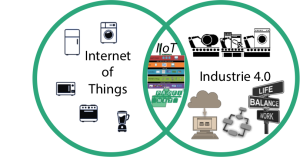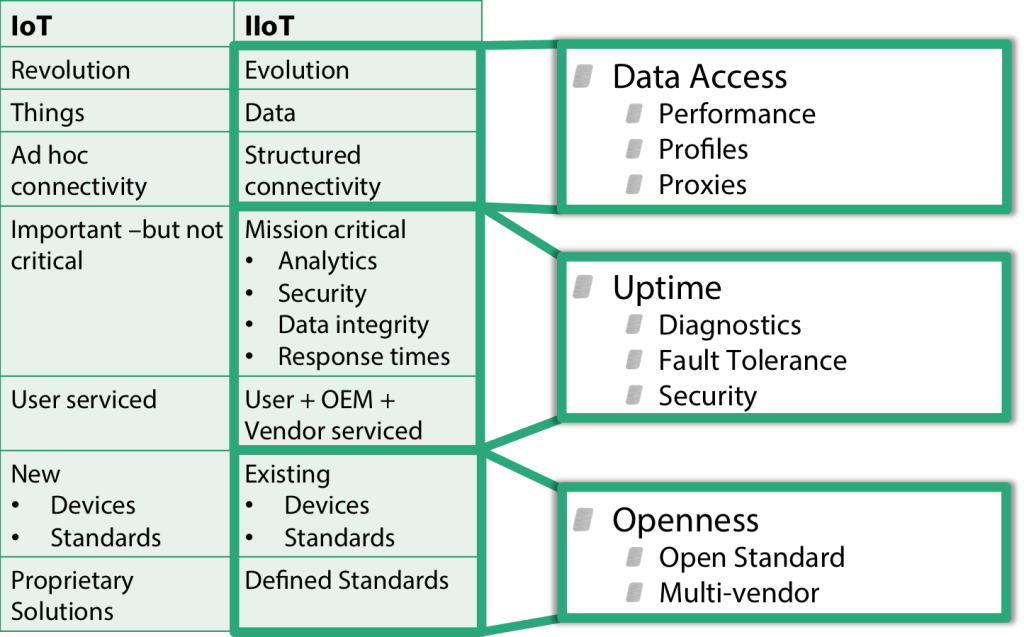By providing deterministic control, data access, and uptime in an open platform, PROFINET is foundational to the Industrial Internet of Things (IIoT) and Industrie 4.0.
 What is the relationship between the Industrial Internet of Things, the Internet of Things (IoT), and Industrie 4.0? The Internet of Things is the network of physical objects—devices, vehicles, buildings, and other items embedded with electronics, software, sensors, and network connectivity—that enables these objects to collect and exchange data. The IoT allows objects to be sensed and controlled remotely across existing network infrastructure, creating opportunities for more direct integration of the physical world into computer-based systems, and resulting in improved efficiency, accuracy, and economic benefit. When IoT is augmented with sensors and actuators, the technology becomes an instance of the more general class of cyber-physical systems that also encompasses technologies such as smart grids, smart homes, intelligent transportation, and smart cities. Each thing is uniquely identifiable through its embedded computing system but is able to interoperate within the existing Internet infrastructure. Experts estimate that the IoT will consist of almost 50 billion objects by 2020.
What is the relationship between the Industrial Internet of Things, the Internet of Things (IoT), and Industrie 4.0? The Internet of Things is the network of physical objects—devices, vehicles, buildings, and other items embedded with electronics, software, sensors, and network connectivity—that enables these objects to collect and exchange data. The IoT allows objects to be sensed and controlled remotely across existing network infrastructure, creating opportunities for more direct integration of the physical world into computer-based systems, and resulting in improved efficiency, accuracy, and economic benefit. When IoT is augmented with sensors and actuators, the technology becomes an instance of the more general class of cyber-physical systems that also encompasses technologies such as smart grids, smart homes, intelligent transportation, and smart cities. Each thing is uniquely identifiable through its embedded computing system but is able to interoperate within the existing Internet infrastructure. Experts estimate that the IoT will consist of almost 50 billion objects by 2020.
Industrie 4.0 or the “fourth industrial revolution” is a collective term embracing a number of contemporary automation, data exchange, and manufacturing technologies. It had been defined as a collective term for technologies and concepts of value chain organization that draws together cyber-physical systems, the IoT, and the Internet of Services. The term “Industrie 4.0” originated from a project in the high-tech strategy of the German government that promotes the computerization of manufacturing.
The Internet of Things includes non-industrial items from the consumer and commercial world, in addition to industrial things. Industrie 4.0 is a holistic look at the manufacturing process that includes the products themselves, the products that make the products, and the people who make them. It’s at the intersection between the Internet of Things and Industrie 4.0 that the Industrial Internet of Things resides. At the core of Industrie 4.0 and the IIoT is the need for interoperability of devices, software, and entire systems. This is where PROFINET provides a foundational role providing data to the IIoT.
The standard for industrial networking in automation, PROFINET is critical to providing data access, uptime, and openness to meet the needs of the IIoT. It connects devices, systems, and cells, facilitating faster, safer, less costly, and higher quality manufacturing. It easily integrates existing systems and equipment while taking the rich functionality of Ethernet down to the factory floor.
PROFINET has evolved over the years to a stable state for the communication protocol while work continues on application profiles, the “objects” that arrange the data consistently. It ensures that the data is delivered at the needed intervals while indicating its quality. Industrial architectures using PROFINET are structured to assure that the topology doesn’t change unexpectedly.
PROFINET Data Access
The use of PROFINET helps ensure highly reliable data access. PROFINET is a high-performance protocol providing the speed required for any application, from microseconds for high-speed IO and motion to milliseconds for discrete IO to hundreds of milliseconds for process instruments to seconds for TCP/IP configuration and diagnostic traffic.
Profiles in the PROFINET world are akin to objects in other protocols. Profiles arrange the data in a consistent format. This can be considered the first place data starts to become information. For example, a drive that uses PROFIdrive has all the parameters in the same place all the time, regardless of vendor. This makes it easier to configure the system and also assists with troubleshooting.
When PROFINET first appeared, there were already tens of millions of PROFIBUS nodes. As users could not be expected to rip and replace existing devices, proxies were developed for PROFIBUS. A proxy provides a consistent mapping of data from one network to another. Proxies worked so well for PROFIBUS that the concept has been extended to a dozen additional networks, including Foundation Fieldbus and DeviceNet. Furthermore, proxies are defined in the PROFINET standard so the use of open standards extends to non-Ethernet networks, ones that will remain in use for years because of applications (e.g., hazardous environments) that cannot currently use Ethernet.
PROFINET Uptime
Uptime is critical to fully realizing the mission critical and professional services characteristics expected of the IIoT. Diagnostics provide a means of preventing downtime and recovering from downtime quickly. PROFINET builds on the concepts of PROFIBUS by providing diagnoses of problems at the device, module, and channel levels. For example, if a device goes offline, a module is missing, or a channel goes down, alarms are sounded. Because PROFINET mandates the use of standard IT protocols such as LLDP and SNMP, network problems can be highlighted and addressed before a shutdown.
Simple Device Replacement is an added benefit of requiring LLDP, enabling replacement of a failed device without using a computer or doing any kind of configuration. PROFINET devices are identified via a name that is assigned in the configuration. When replacing a defective device, a new device can be recognized by the IO Controller by means of topology information and have a name automatically assigned to it. An engineering tool is therefore not required when replacing devices, saving time and minimizing downtime.
One sure way to make certain the automation system keeps running is to have redundant network media (and redundant networks), redundant controllers (i.e., “hot standby”), and redundant devices, all of which PROFINET supports. PROFINET also supports redundant wireless access points, and is the only Industrial Ethernet that has this level of fault tolerance.
PROFINET Openness
A major driving force of the Industrial Internet of Things and Industrie 4.0 is the reliance on open standards. PROFINET devices are manufactured according to the PROFINET specification (IEC 61158). PROFINET is Ethernet, IEEE 802.3. Many other standards also come into play with PROFINET and the IIoT, including:
- IEC 61784
- IEC 61508
- IEC 61784-3-3
- IEEE 802.11 (b, g, a, h, n, ac)
- IEEE 802.15.1
- IEEE 802.1AB
- RFC 1155
- RFC 1213
- RFC 1157
One challenge for the IIoT is accessing devices that do not have an IP address. Some devices are just too simple and inexpensive to have any electronics in them. A mechanical limit switch can connect to PROFINET I/O, so no difficulty there; but what about devices that do have electronics, but no Ethernet controller? Devices connected to legacy networks fall into this category. PROFINET addresses this as part of the PROFINET specification. Using proxies that have standardized, specified data mapping, PROFINET integrates PROFIBUS DP, PROFIBUS PA, Interbus, DeviceNet, Foundation Fieldbus, and many others. This open specification approach to non-Ethernet networks is a PROFINET exclusive.
The user benefits from open standards with longer supported lifetimes compared to proprietary standards, as well as having multiple vendors competing for their business, which helps keep pricing competitive.
The Three Essentials
PROFINET fits the IIoT and Industrie 4.0 by delivering three essential functions: deterministic control, data access, and uptime maximization. The fact that it is an open network—the most open network—means that other applications can run seamlessly on the same wire as PROFINET, and in doing so support both agility and the full scope of next-generation manufacturing. To that end, PROFINET is well positioned to facilitate the realization of Industrie 4.0 by helping it effectively leverage the power and functionality of the IIoT.
For additional resources on the PROFINET of Things, visit PROFINETofThings.com.

